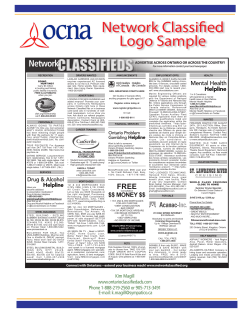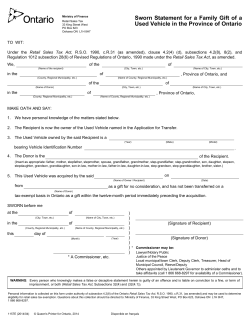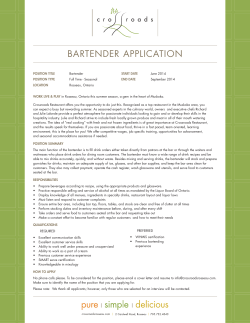
What is an Archive?
What is an Archive? ar·chive Pronunciation: är- k v Function: noun 1 : a place in which public records or historical documents are preserved; also : the material preserved -- usually used in plural 2 : a collection of information Function: verb Inflected Form(s): ar·chived; ar·chiv·ing : to file or collect in or as if in an archive <was archiving documents> Over the course of a lifetime, most people accumulate a variety of records. Taken together, these records can provide a fascinating view into someone’s life and into the past. Like a detective investigating a case, a researcher using these records can get a sense of what a place looked like, what people were thinking, what life was like, and what happened and why. Historians use these records as primary sources for writing about and understanding the past. Some examples of primary source that a historian may use are: birth, death, and marriage records letters or diaries photographs, sketches, and paintings court records audio, video and film records An archive is a place where these records and historical documents are preserved. The Archives of Ontario collects and preserves records with relevance to the history of Ontario. The Archives of Ontario The Archives of Ontario is the largest provincial archive in Canada, with a collection that includes 2.9 MILLION photographs, more than 85,000 maps of Ontario, 240,000 architectural drawings, and over 30,000 hours of audio, video and film records. These records date back to 1729, and reflect all aspects of public and private life in Ontario. The core of the Archives’ collection is made up of Ontario government records. Stacked up, these documents alone would be 100 kilometres high—taller than 180 CN Towers. Types of Records: Ontario Government Records The majority of the records in the collections of the Archives were created by the government of Ontario. These records date from the late eighteenth century to the present day. They document political and legal decisions, the evolution of provincial administration, the interaction between the government and its citizens, and provide key evidence of the rights and responsibilities of Ontarians. Private Sector Records Since 1903, the Archives of Ontario has been acquiring records from the private sector. The Archives holds the records of over 2600 private individuals, businesses, clubs and associations, labour and political organizations. These records include paper files, diaries, photographs, maps, architectural records, sound recordings and moving images. These collections can range in size from one or two items to thousands of items that occupy hundreds of metres of shelf space. Genealogical Records The Archives of Ontario holds many important sources for researching family history in Ontario. There is no single finding aid or database for this type of research Vital Statistics By far our most popular records are historical registrations of births, marriages and deaths. Special Collections Photographs Cartographic Records Architectural Records Caricatures and Cartoons Poster Collection Sound and Moving Images The Government of Ontario Art Collection The Archives in Action – 1 People use the Archives of Ontario for different reasons. This map is a good example. This patent plan of Seneca Township from 1842 can be used in many different ways by different people. Who do you think could use this map? What purposes could this map be used? Patent plan of Seneca Township Patent plans Reference Code: RG 1-100, C-51 Archives of Ontario The Archives in Action – 2 We’ve identified some ways people could use this map when they visit us in the Reading Room. Can you think of any others? Genealogists research family history and collect documentary evidence of family events. They would use this patent plan to: connect an individual to a particular lot of land map out a person’s relationship to surrounding families help prove an ancestor’s status as a patentee or original owner of a lot. Students like you can learn directly from primary source materials by appreciating the context for historic events. A student would use the map to understand how land was granted see a visual representation of the settlement of Ontario. First Nations people use archives to examine evidence of traditions and especially to provide legal right to lands or native status. This map might show original reserve boundaries. Propertyowners may need to research the history of their land or building and determine boundaries. Maps can be used to show the size and shape of the original lot. show who lived on the land. Archaeologists collect evidence to support conservation of an area as historically important and will plan excavation activities using evidence of early settlements. Maps such as this can be used to locate early and important settlements. identify areas with historical significance that should be preserved. Environmental engineers gather information about plots of land for corporate clients or environment groups. Maps can be used to uncover past uses of land that may impact on new development; for example, church reserves, industrial use, mining rights, or historical significance.
© Copyright 2025
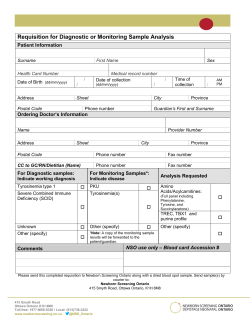
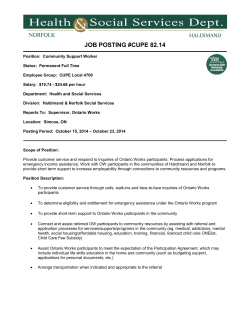
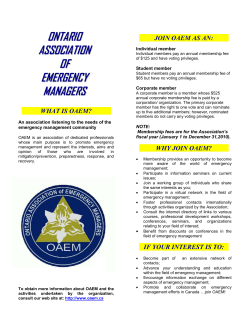


![Mid Western Ontario District Event [Oakville]](http://cdn1.abcdocz.com/store/data/000192548_1-753105a447977030eda8c92bf1e983c6-250x500.png)
